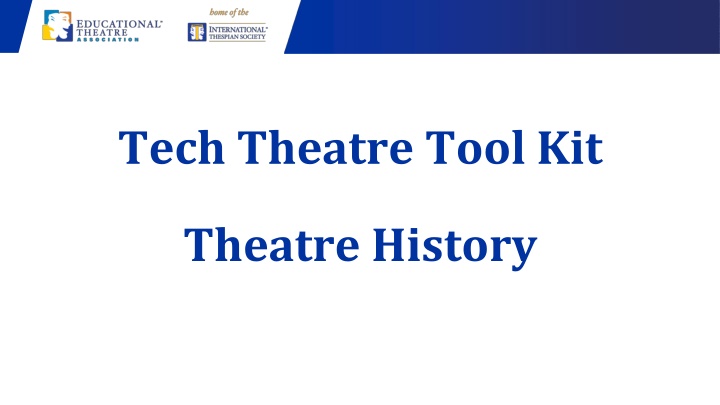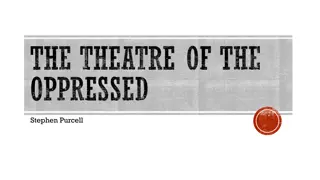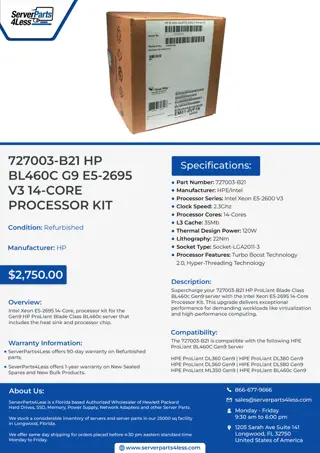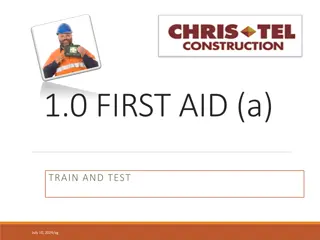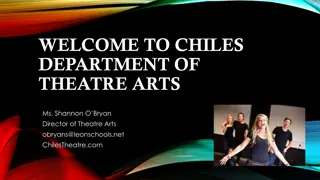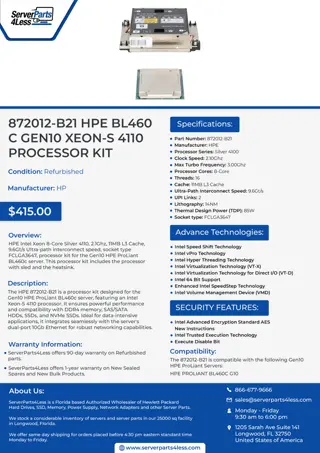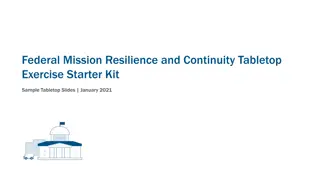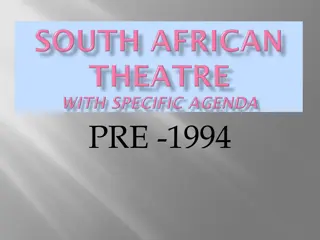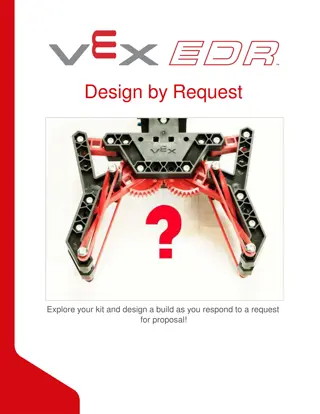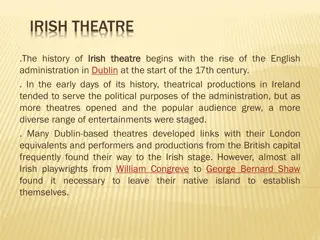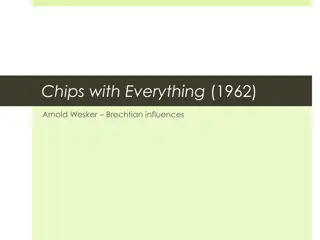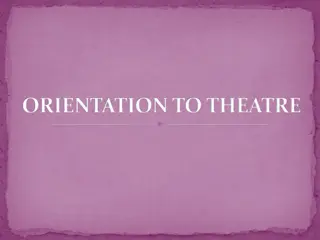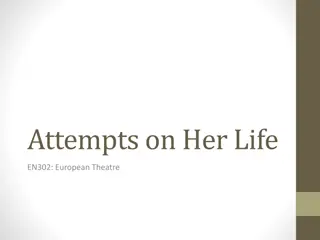Tech Theatre Tool Kit & Theatre History Overview
Dive into the world of technical theatre and theatre history through essential elements, design principles, and hands-on activities like building performance spaces. Explore Greek theatre terms, orchestra setups, and more.
Download Presentation

Please find below an Image/Link to download the presentation.
The content on the website is provided AS IS for your information and personal use only. It may not be sold, licensed, or shared on other websites without obtaining consent from the author.If you encounter any issues during the download, it is possible that the publisher has removed the file from their server.
You are allowed to download the files provided on this website for personal or commercial use, subject to the condition that they are used lawfully. All files are the property of their respective owners.
The content on the website is provided AS IS for your information and personal use only. It may not be sold, licensed, or shared on other websites without obtaining consent from the author.
E N D
Presentation Transcript
Tech Theatre Tool Kit Theatre History
Designed and Created by Brandon Goodman Houston Texas brandonkgoodman@katyisd.org
Unit 1 - Technical Theatre Week Days Objective Standards Essential Questions Paperwork Core Values, Elements of Design, Personality Types Notes TH:Cn10.1.I. TH:Cn10.1.II. TH:Cn10.1.III. How do you connect to the world of theatre? What essential elements are needed for a theatrical performance? How has society shaped the way we view theatre through performance spaces? What elements of the space have stayed constant over the history of Theatre? How can we incorporate the 5S model into our daily lives? How does a clean workspace affect productivity? Aug 14 - 16 3 Introductions TH:Cn10.1.I. TH:Cn10.1.II. TH:Cn10.1.III. Aug 19 - 23 5 Types of Stages 21st - PAC TOUR TH:Cn10.1.I. TH:Cn10.1.II. TH:Cn10.1.III. Types of Stages Quiz Aug 26 - 30 5 Theatre History TH:Cn10.1.I. TH:Cn10.1.II. TH:Cn10.1.III. TH:Cn10.1.I. TH:Cn10.1.II. TH:Cn10.1.III. TH:Cn10.1.I. TH:Cn10.1.II. TH:Cn10.1.III. Sept 3 - 6 4 Stage Diorama Sept 9 - 13 5 Tool Safety 5 - S Sept 16 - 20 5 Tool Application Tool Test Production Week
TheatreHistory/Stages Hands on Activity: Building a performance space. (students need to bring a shoe box thisweek)
Greek Theatre:Terms Greek tragedies and comedies were always performed in outdoor theaters. Early Greek theaters were probably little more than open areas in city centers or next to hillsides where the audience, standing or sitting, could watch and listen to the chorus singing about the exploits of a god or hero. From the late 6th century BC to the 4th and 3rd centuries BC there was a gradual evolution towards more elaborate theater structures, but the basic layout of the Greek theater remained the same.
Orchestra Orchestra: The orchestra (literally, "dancing space") was normally circular. It was a level space where the chorus would dance, sing, and interact with the actors who were on the stage near the skene. The earliest orchestras were simply made of hard earth, but in the Classical period some orchestras began to be paved with marble and other materials. In the center of the orchestra there was often a thymele, or altar. The orchestra of the theater of Dionysus in Athens was about 60 feet in diameter.
Skene Skene: The skene (literally, "tent") was the building directly behind the stage. During the5th century, the stage of the theater of Dionysus in Athens was probably raised only two or three steps above the level of the orchestra, and was perhaps 25 feet wide and 10 feet deep. The skene was directly in back of the stage, and was usually decorated as a palace, temple, or other building, depending on the needs of the play. It had at least one set of doors, and actors could make entrances and exits through them. There was also access to the roof of the skene from behind, so that actors playing gods and other characters could appear on the roof, ifneeded.
Parados Parodos: The parodoi (literally, "passageways") are the paths by which the chorus and some actors (such as those representing messengers or people returning from abroad) made their entrances and exits. The audience also used them to enter and exit the theaterbefore and after the performance.
Additional Greek Theatres http://www.perseus.tufts.edu/hopper/artifactBrowser?redirect=true &object=Building&field=Type&value=Theater
Roman TheatreStage Carole Raddato from FRANKFURT, Germany [CC BY-SA 2.0 (https://creativecommons.org/licenses/by-sa/2.0)]
RomanTheatre What did the Romans copy from the Greeks when designingtheir theatres? What words are similar?
Scaenae Scaenae: The whole of scene and all theelements and rooms for a right working of performings was placed on a podium that made it upper than the orchestra.
Scaenae:proscaenium We can distinguish different parts: Proscaenium: the space for actors to play. It was placed on the podium, between orchestra and scaenae frons. Its part near the orchestra was called pulpitum and was often more elevated. Its surface was usually covered with wood. Below it there was the hiposcaenium, a hidden chamber for decoration and machines. At the orchestra elevation there was a fa ade called frons pulpiti. We can point it out as the scene where actors play.
Scaenae: scanaefrons Scaenae frons. It was the monumental wall that limited back part of proscaenium. It is doubtless the most spectacular part of the scaena. It was composed by one or several superposed orders with their columns and entablatures, crowned by a roof with a double function: acoustic and preservative. There were three doors at it: the central one or valva regia and two at both sides: valvahospitalarium.
Additional Roman Theatres https://en.wikipedia.org/wiki/List_of_Roman_theatres
Italian Theatres Commedia Del Arte https://en.wikipedia.org/wiki/List_of_Roman_thea tres
TeatroOlimpico The Teatro Olimpico is the first indoor theater in masonry in the world, with interiors made of wood, stucco and plaster. It was constructed between 1580 and 1585. Teatro Olimpico [CC BY-SA 4.0 (https://creativecommons.org/licenses/by-sa/4.0)]
Elizabethan Theatre The GlobeTheatre
TheGlobe Jeff Hitchcock [CC BY 3.0 (https://creativecommons.org/licenses/by/3.0)]
ElizabethanTheatre Hut Gallery Upper Stage Door Main Stage Pit Trap Door Discovery Space Tiring Room Wardrobe Storage Frans Scenae Flag Color Comedy -White Drama - Black
Japanese Theatre Noh Kabuki -Bunraki
Japanese Theatre:Noh The noh stage is an extremely simple space in which there is no curtain between the playing area and the audience. Originally, noh was played in open fields. In order to retain the idea of performing outdoors, the modern noh stage, though fashioned indoors, is designed complete with details such as a roof, bridge with a handrail and a pine tree painted on the back wall. Photo credit:Wikimedia Commons
Japanese Theatre -Kabuki Kabuki is a classical Japanese dance-drama. A Kabuki stage setup is essential to the production of Kabuki plays. Stage left, kamite, is usually where you see the important or high-ranking characters. Stage right, shimote, is usually where low ranking characters are. Many stages have a catwalk, revolving sections, trapdoors, scenic backdrops and platforms that can be raised and lowered. Photo Credit: Joe Mabel [CC BY-SA2.0 (https://creativecommons.org/licenses/by -sa/2.0)]
Japanese Theatre:Bunraku Bunraku is a Japanese traditional puppet theatre using half life sized puppets. The Bunraku stage includes a lowered portion where the puppeteers stand in full view of the audience. Musicians sit off stage. Photocredit: Leo Rodman [CC BY-SA 2.0 (https://crea tivecommon s.org/license s/by-sa/2.0)] http://www2.ntj.jac.go.jp/unesco/bunraku/en/contents/whats/images/st age.jpg
Assignment: theatremodel Select a Theatre You will use your shoe box to recreatethe elements of one of the theatres we have discussed. You diarama needs to be labeled with the parts we covered. Photos of Theatres on googleslides Have them label parts on the slides as well as the diorama
Guide to Building Theatres Tools needed tocomplete
How to use a tapemeasure Tape MeasureProcedures 1. Never pull tape measure past intendedlength 2. Tape is sharp and can cutyou - never use quick release to coiltape 3.Replace Tape Measure after each usein proper home.
Technical Theatre Week 4
Students Present Types of Theatres Can expand as needed.
